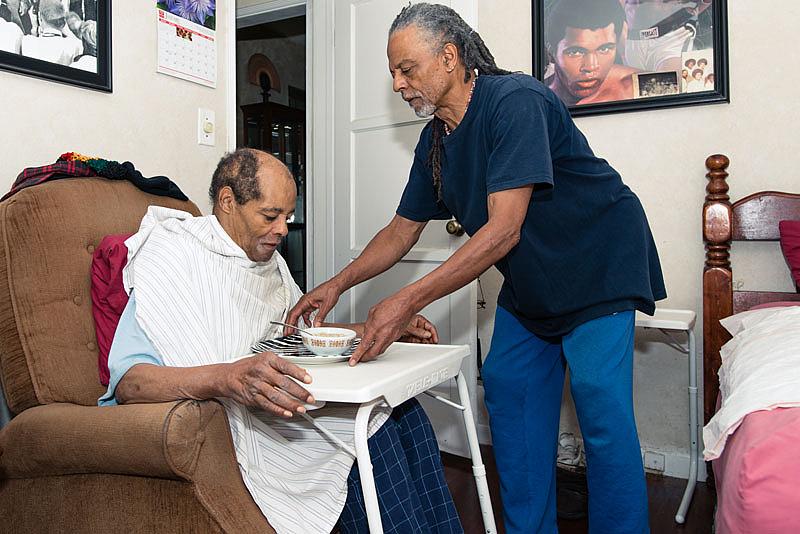In-home caregiving deserves strong coverage in your state

(Photo by Heidi de Marco/Kaiser Health News)
When I first started exploring the issue of in-home care, a professor warned me that there was a dearth of information available about caregivers. He explained that you could learn more about the person you hire to build your kitchen cabinets than the person you hire to care for your elderly parent.
In many ways, he was right.
There is little data available on in-home caregiving, which of course makes reporting on the issue incredibly difficult. Unlike nursing homes, in-home care suffers from little regulation, licensing or oversight. And the care occurs behind closed doors of frail people’s homes.
Despite the challenges, reporters interested in the issue shouldn’t be deterred. It’s precisely that lack of information and the vulnerability of the elders that makes this an important topic.
Over time, more and more people will receive care in their homes rather than in nursing homes. Personal care aides are the second fastest growing profession in the U.S., according to the Bureau of Labor Statistics. That is in large part because of the aging of the population and the fact that people don’t want to go to institutions. The shift is also driven by incentives built into the Affordable Care Act and a push to cut costs. Overall, care in the home is much less expensive than care in a nursing home.
As I started looking into in-home care, I quickly realized the topic was broad. There are various sources of caregivers – private agencies, independent providers, relatives and publicly funded caregivers.
I decided to narrow my stories by focusing on the state-run program in California, known as In-Home Supportive Services. Through the program, California pays caregivers for nearly half a million low-income elderly and disabled people so they can stay in their own homes. The program has a budget of over $7 billion. About three-quarters of clients are related to their caregivers.
The way the program is set up, the clients are in charge of hiring, training, supervising and firing their caregivers. While IHSS is a great program for many disabled and elderly people, not everyone is capable of doing that, and In-Home Supportive Services, or IHSS, simply doesn’t work for everyone.
The reporting led to me to two investigative stories, which we did as both print and radio pieces. The stories ran on our website and on the site of our primary partner, Southern California Public Radio (KPCC). The stories also ran on KQED, several newspapers around the state, Huffington Post and The Atlantic.
The first story was about how the lack of oversight in the program can put people at risk of abuse and neglect. The second story addressed how the caregivers were not required to do any training, despite what was at stake.
Many people told me that abuse and neglect was common among IHSS caregivers. But with no data available on abuse cases, and the list of caregivers not publicly available, I relied heavily on police and prosecutors around the state to provide cases for me to include. But there was an added challenge there too – not everyone tracks whether the abusers are paid caregivers, or whether they are part of the IHSS program. It became clear that the cases that become public are likely only a small fraction of the abuse that occurs.
My reporting focused on California’s program, but this is a national issue and reporters can look to their own states to find out how and if the state governments fund caregivers and what holes the public programs may have.
There are endless questions to ask: Are publicly-funded caregivers required to be licensed? Do they have mandated training? What sort of oversight occurs? Is it enough? How do states ensure that people are safe in their own homes? How do states discover or document the scope of abuse and neglect?
As reporters begin to explore publicly-funded caregivers and abuse by caregivers in their own states, here are a few resources.
- The Paraprofessional Healthcare Institute is sort of a clearinghouse for information about in-home caregiving. The organization advocates for more training and policies to improve the workforce, but it also has state-by-state resources and statistics. There are also people within the organization who are really knowledgeable about this workforce.
- UC San Francisco Health Workforce Research Center is a new center based in San Francisco that does research nationwide on whether the workforce is prepared to meet the needs of the aging population in the U.S. Their most recent report looks at the demographics, socioeconomic status and job mobility of long-term care workers.
- National Center on Elder Abuse is based at the School of Medicine of the University of Southern California. The center works with states to develop programs to target abuse and neglect. The staff also conducts research and advocates on behalf of the elderly.
- National Association for Home Care and Hospice is a nonprofit organization representing home care and hospice organizations. It is a good place to find out – from the home-care workers’ perspective – what is going on in the field.
In reporting on in-home care, I would offer one last piece of advice. Regulating in-home care further draws very strong opinions. I would encourage reporters to reach out to people from all different sides of the issue — caregivers, clients, doctors, elder abuse experts, unions, prosecutors — to make sure they have a good understanding of the different views before they start writing.
Photo by Heidi de Marco/Kaiser Health News.

